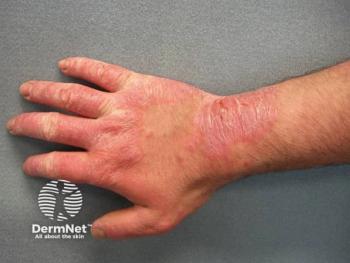
LEO Pharma’s Robert Spurr on Delgocitinib Cream’s Approval and the Future of Chronic Hand Eczema
Key Takeaways
- Delgocitinib cream is the first FDA-approved non-steroidal treatment for moderate to severe chronic hand eczema, offering a new option for patients unresponsive to corticosteroids.
- Clinical trials showed delgocitinib significantly outperformed placebo, achieving primary endpoints with notable improvements in skin clearance and symptom relief.
Delgocitinib cream recently became the first FDA-approved treatment for chronic hand eczema. Robert Spurr of LEO Pharma shares insights into what it means for providers and patients.
Last week’s US FDA approval of delgocitinib cream (Anzupgo; LEO Pharma) for the treatment of moderate to severe chronic hand eczema (CHE) marks a milestone in dermatological care.1 As the first and only FDA-approved treatment for this condition, delgocitinib offers a non-steroidal, pan-Janus kinase (JAK) inhibitor for patients who have not responded adequately to topical corticosteroids.
Dermatology Times recently spoke with Robert Spurr, executive vice president, North America, LEO Pharma, to dive deeper into what this approval means for patients and the future of treatment for CHE.
An Exciting Moment for Dermatology
"It's extremely exciting for us here at LEO Pharma," says Spurr, reflecting on the significance of the approval. "Chronic hand eczema is such a debilitating disease. It affects 1 in 10 people, and in addition to that, to be the first and only chronic hand eczema product on the market gives us great thrill for what we think we can do for patients."
This approval holds particular importance for patients who have long struggled with limited treatment options. As Spurr highlighted, delgocitinib is not just the first treatment specifically for CHE, but it is also the first and only topical treatment approved to work across all subtypes of this heterogeneous condition.
Transforming the Standard of Care for CHE
Spurr emphasized the uniqueness of delgocitinib's broad effectiveness as he discussed the impact of the approval.
“What we are really excited about is that delgocitinib is a pan-JAK, and that means it works across all of the subtypes of chronic hand eczema,” he noted. “What we think it will do for providers is it will provide them [an option] after they've tried steroids, and steroids just either weren't right or weren't effective. For patients, they will have a second line option to go to that'll work across all the subtypes.”
The efficacy demonstrated in the clinical trials is significant, with delgocitinib significantly outperforming placebo. Results from the phase 3 DELTA-1 and DELTA-2 trials demonstrated that over 16 weeks, significantly more patients using delgocitinib achieved clear or almost clear skin—20% in DELTA-1 and 29% in DELTA-2—compared to 10% and 7% in the respective vehicle groups, meeting the trials' primary endpoints.2
“The efficacy of the product was substantial against what we saw in placebo,” Spurr said. “It beat both its first and secondary endpoints in its DELTA-1 and DELTA-2 trials for submission to the FDA.”
These pivotal trials also demonstrated that delgocitinib not only addresses skin clearance but also improves symptoms like pain and itch, which are key to improving the quality of life for patients with chronic hand eczema.
“All the issues around side effects were less than 1% or comparable to the vehicle,” Spurr added.
A Key Differentiator in CHE
What sets delgocitinib apart in the crowded field of dermatology treatments is its safety profile, Spurr emphasized. Unlike other treatments that may carry more severe warnings, delgocitinib’s approval comes without a black-box warning.
“We think will stand out for providers and for patients as well, giving them an extra sense of safety and security that they're being treated with something that's very safe without compromising efficacy,” he said.
Next Steps: Access and Support for Patients
As LEO Pharma moves forward with commercialization, patient access remains a key priority, Spurr noted, also highlighting the importance of the company’s Patient Support Program, which willfacilitate access to the product immediately after launch.
He also mentioned the importance of collaboration with clinicians to make sure they understand how to use the product effectively.
“We want the providers and the patients to know that they'll be supported by a strong and easy to access the patient services program,” Spurr said.
Further Research and Expanding Indications
Beyond the immediate approval for CHE, LEO Pharma is already exploring additional indications for delgocitinib.
“There was some research that we've done in adolescents. We published some of that in February at a derm meeting,” Spurr said. “Then, we're looking at palmar pustulosis, which is another indication for the future... We'll continue to develop the product for those other needs.”
For patients living with CHE, delgocitinibrepresents more than just a new treatment option: It signifies hope and progress.
“It is the first and only is really important to us, but it's first and only from an efficacy standpoint. We want to underline those DELTA-1 and 2 trials,” Spurr said. “This is just the beginning. We're excited to be part of this transformation in patient care.”
References
- Anzupgo (delgocitinib) cream is now the first and only FDA-approved treatment for moderate-to-severe chronic hand eczema (CHE) in adults. News release. LEO Pharma Inc. July 23, 2025. Accessed July 29, 2025.
https://www.businesswire.com/news/home/20250723115252/en/ANZUPGO-delgocitinib-Cream-Is-Now-the-First-and-Only-FDA-Approved-Treatment-for-Moderate-to-Severe-Chronic-Hand-Eczema-CHE-in-Adults - Bissonnette R, Warren RB, Pinter A, et al. Efficacy and safety of delgocitinib cream in adults with moderate to severe chronic hand eczema (DELTA 1 and DELTA 2): results from multicentre, randomised, controlled, double-blind, phase 3 trials. Lancet. 2024;404(10451):461-473.
doi:10.1016/S0140-6736(24)01027-4
Newsletter
Like what you’re reading? Subscribe to Dermatology Times for weekly updates on therapies, innovations, and real-world practice tips.



















